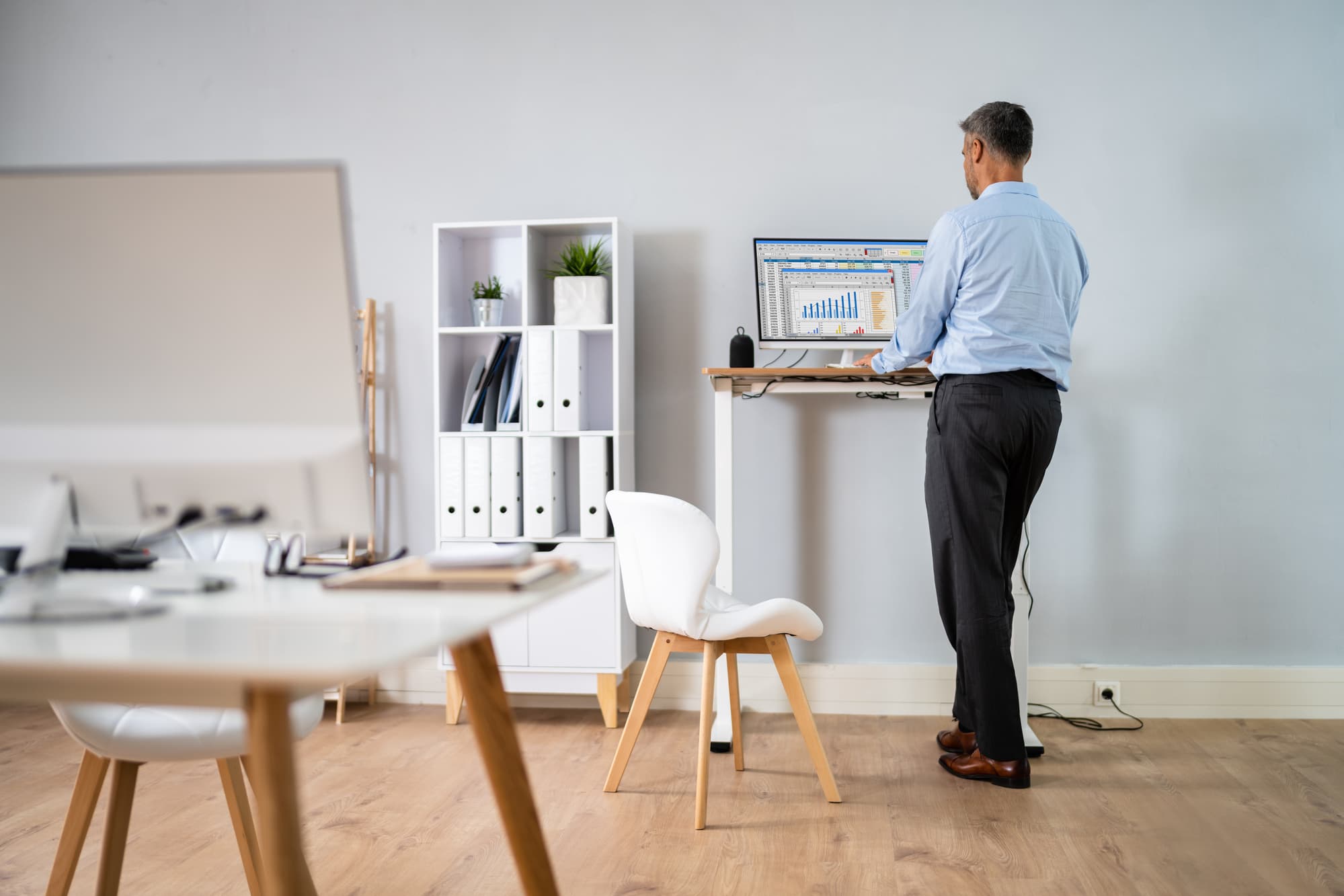Working from home has become the norm for most of us. This new work set-up, however, also made desk jobs cumbersome. Many then started using standing desks to adjust.
But while these innovative furniture pieces are beneficial, you might be asking: does standing desk help neck pain?
Sitting And Standing For Comfort At Work
The short answer to our neck pain question is yes, and no. The standing desk does help ease neck and back pain. But you need to combine it with other methods for complete relief and prevention.
Prolonged standing at work poses nearly the same problems as sitting for hours.
And so, one solution for neck pain or musculoskeletal disorder (MSD) prevention is to combine sitting and standing positions while working.
In the following parts of this article, we will discuss why such pain ensues. We will also share some steps on how to prevent this from recurring.
Why Is It Common For Office Workers To Suffer From Neck Pain?
Neck pain is typical among people with desk jobs. This MSD is a public health problem since it significantly affects workers’ health and productivity.
In addition, a study showed that 90% of workers spend over 4 hours of work per day using the computer.
Hunching on your work desk, whether seated or standing, aggravates the body and, in turn, leads to body pains.
Here are more factors related to neck pain that employees need to know and understand.

1. Lack Of Ergonomics
An office cubicle or work-from-home set-up that does not use ergonomics leads to bad posture, which affects the body’s muscles and joints.
When considering potential disruptions in the workplace, ergonomics often takes the back seat.
It’s because poor ergonomics are not as apparent as onsite injuries caused by unsafe chemicals or slipping and falling hazards.
But MSDs from lack of ergonomics are just as dangerous to employees’ health and well-being.
2. Uninterrupted, Long Hours Of Work
Working continuously without breaks can aggravate the body, affecting our mental and physical states. Employees working from home are often affected as they often have no reason to go out or move more.
3. Physical Inactivity
A sedentary lifestyle is another contributing factor to neck pain and other MSDs. Lack of exercise and other forms of physical activity strains the muscles and leads to pain whether you’re at work or not.
With preventive exercise, plus stretching and conditioning moves, workers can then lessen the risk of MSDs.
4. Prolonged Static Posture
Sitting or standing for a long time leads to body aches and pains. Holding the neck, for example, in a partially-flexed position for an extended period increases the risks of neck pain.
Holding this position for a long time also forces the neck and back muscles to keep other body parts, like hands, fingers and arms, stable. In turn, recurring strain and muscle tension happen.
Sitting continuously also hurts the spine’s natural curvature. It also leads to pressure accumulation on the muscles, the vertebral discs and the ligaments.
5. Moving From One Bad Posture To Another
People often make the mistake of getting into a bad sitting posture and then slumping down. Because of this, the muscles and the bones cannot rest and realign properly. All of which also impact the neck, the lower back and the knees.
6. Psychosocial Factors
Increased stress levels can also boost neck pain risks. Women, in particular, have this constant tendency to bring stress to their shoulders and neck. Anxiety, low morale and depression can also amplify the risks of acquiring neck pain.

How To Manage Neck Pain For Office Workers?
While employees are at high risk of recurring neck pain, there are ways to create a more comfortable work environment. Here are tips that you can apply.
1. Stand More
Stop the sitting disease from deteriorating your health by using a standing desk. Does standing desk help neck pain? Yes, especially when you alternately sit and stand during your workday.
You can try spending at least 1 hour of work standing up. If you want to be more comfortable in your desk job, you can also use an anti-fatigue mat to go with your standing desk.
2. Sit Properly
Investing in ergonomic chairs is one way to ease body pains. These chairs provide excellent lumbar support and are adjustable.
Try reclining your chair at 25 to 30 degrees. This position should reduce pressure on the neck and the discs and prevent you from slouching. Also, the neck muscles at the back need not contract to support the head.
Furthermore, as you lean back, a part of your body’s weight will not go to the spine and instead will be directed to the chair. In turn, there will be less pressure and discomfort on the spine.
3. Fix The Screen Height At Eye Level
If you constantly look down when viewing your computer screen, you have to adjust your screen pronto.
On the other hand, laptops often require users to slant their heads down to check the monitor. In this case, you can try connecting the device to another screen.
The keyboard must be sufficiently near, too, so your elbows are bent at a 90-degree angle. Make sure to position it high enough to avoid slumping your shoulders down while typing.
Also, do not forget to keep your mouse and keyboard aligned.
4. Try Ergonomic Office Items
Ever thought of using ergonomic keyboards for work? These devices can help reduce muscle strain.
Fixed split keyboards, for example, have three sections, allowing their users to type at various angles.
On the other hand, adjustable split keyboards have separate pieces, so users can change angles as needed.
It takes some getting used to, but these ergonomic keyboard types are excellent for users with pinched nerves in the neck and hands.

5. Move Around
Good sitting and standing positions are not enough to keep those pains away. You also need to fidget or move about every once in a while.
For instance, you can set an alert to remind yourself that you need to start walking or stretching.
Walk around in your office cubicle or home workspace. Do some stretches. Get into simple exercises: run in place, bend over and touch your toes or do jumping jacks.
You can refill your pot of coffee or water bottle. Also, take calls while standing up, prepare some snacks or do arm circles for better blood flow.
Check out these tips to sit less at work for more ideas.
6. Exercise
Exercise helps in neck pain relief and prevention since it encourages blood circulation to tired muscles. It also flushes out chemicals that cause pain and inflammation.
Some excellent exercises that you can try are jogging, recumbent biking, elliptical cycling, swimming or brisk walking.
Make sure to choose an aerobic exercise that will not give you neck pain, though. Also, start your routine for 20-30 minutes, three to four times a week.
Conclusion
We cannot answer the question does standing desk help neck pain with a definite yes or no. However, we now know that a standing desk is not the sole solution.
A mix of methods is necessary to alleviate neck pain and prevent it from reoccurring. And these include the inclusion of ergonomics, correct sitting and standing habits, and movement variety.
Informative Q&A
1. How does poor posture affect productivity?
Poor posture, if left unmanaged, can lead to musculoskeletal disorders (MSDs). These cause body pain and discomfort, particularly in the lower back. If your body is constantly in pain, then productivity is affected significantly.
2. How to keep active while working from home?
There are many ways to keep yourself active while working from home. You can shift body positions, use a standing desk, take conference calls while walking around the house, prepare lunch or snacks, or walk or climb the stairs.
You can also use work-friendly exercise equipment if you like. Read this article on exercises for a remote work setting to learn more.
- 6 Benefits of Using Seat Cushion - February 20, 2024
- 4 Tips to Fix Uncomfortable Chair - February 19, 2024
- How to Position Lumbar Support on Ergonomic Chair - February 15, 2024

